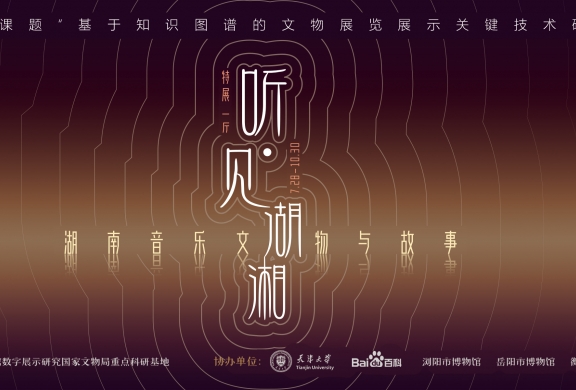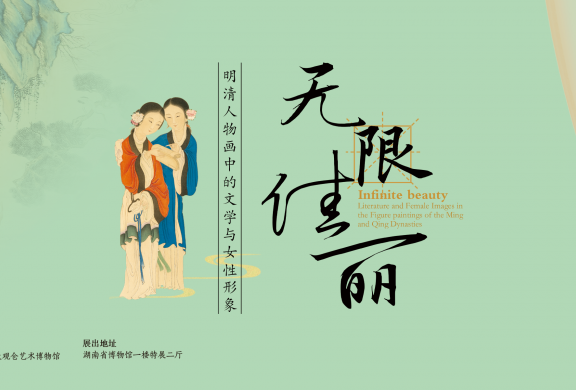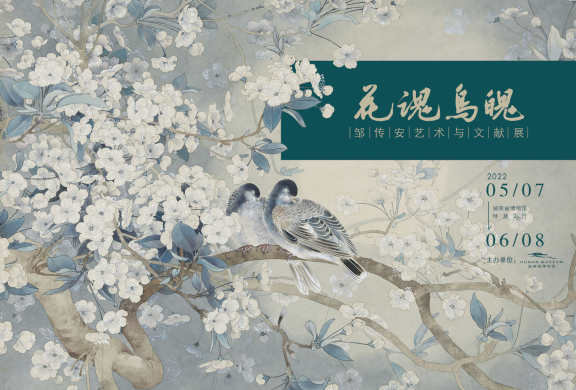Past Exhibitions
Hearing and Seeing Huxiang - the Exhibition of Hunan Musical RelicsNo.1 Special Exhibition Hall 2022.07.28 - 2022.10.30
Foreword Music is the forerunner of civilization, nourishes the childhood of human beings, and carries the future of the nation. Hunan is located in the middle reaches of the Yangtze River, south of Dongting, and is one of the important cradles of Chinese civilization. The landscapes in Hunan are gorgeous, everything is vigorous, and rivers flows for ages, nurturing unique and rich musical culture. More than 6,000 years ago, the sounds of ancient musical instruments(stone whistles, pottery balls and pottery drums) flied on the Liyang Plain, accompanied by the joy of work; on the banks of the Weishui River, resounding with the sound of Nao of the Shang and Zhou Dynasties; on the banks of the Miluo River, the sorrow of Quyuan echoed; various types of musical performances acted in the Han and Jin Dynasties; exotic music prospered in the Sui, Tang, Song and Yuan Dynasties; ancient music of Liuyang opened a new chapter in ritual music culture. Music is the common language of all mankind, thousands of years have passed, can these silent notes in history be awakened again today? Listen,the sound of Huxiang—the most beautiful language, either whispered or chirped, soothing or abrupt, soft or strong, deep or distant, tells the longing and call of the ancestors of Huxiang for a better life. Let us start a wonderful audio-visual journey in this eternal and beautiful music world! Chapter One In the late Shang and the early Zhou Dynasties, local artisans in Hunan, a region influenced by the Shang culture of the Central Plains, created a large bronze musical instrument-Nao. The further development of bronze instruments such as Nao, Zhong, and Bo, and the determination of two-tone effect, laid the foundation for the ritual music culture of the Zhou Dynasty. Chapter Two From the mid-Spring and Autumn Period to the Warring States Period, Hunan was incorporated into the territory of Chu(State), and its music culture showed the solemn and profound, romantic and sentimental beauty of Chu tunes, including the ritual music needed to maintain the ritual system, as well as the folk music to release the mind, and the verses of Chu, which not only pleased people, but also entertained the gods. The diversity of musical instruments has also foster the "Eight-Tone Harmony" musical performance form, which constituted the grandeur of Chu’s music and dance. Chapter Three Since the Qin and Han Dynasties, Hunan has become an important part of China's unified multi-ethnic country, and many material relics of musical culture have been left throughout the ages. During the period of the Han, Wei and Jin Dynasties, the traditional Chinese music form changed from the ritual music to the dance music, and a large number of excavated objects and portrait bricks and stone reliefs of Han Dynasty showed various types of musical performances that combined instrumental music, singing and dancing, acrobatic and other art forms at that time, reflecting time features of people’s pursuit of high-quality and joyful life. Chapter Four The Tang Dynasty saw unprecedented prosperity in culture and art, with unprecedented development in dance music, especially court ·music, and the exotic style was also spread to the land of Hunan. From the late Tang Dynasty to the Song Dynasty, the music of the literati became unique, and the entertainment culture of the citizens also flourished, especially during the Yuan and Song Dynasties, the dramas were popular throughout the country. The musical relics unearthed in Hunan reflected the flourishing musical art achievements of this period under the heyday of national unification. Chapter Five Since the Ming and Qing Dynasties, Huxiang music has entered a new stage of historical development, people of civil and military ability could express their political aspirations through music, conveying their sentiments of governing the world and saving the country, as well as their desire to survive and innovate. In addition, there is music of the ethnic groups, which is cheerful and joyful, commemorates the spirits of the ancestors, and encourages production.The "Ding Festival" at the Wenmiao Temple in Liuyang is a direct testimony to the traditional culture of respecting Confucianism, and highlights the magnificent music of Hunan. Last Chapter Gathering together, on the shore of Hunan, the ancient music is still in the ears, and the familiar melody comes out naturally. Ancient poetry and paintings are displayed, the music is melodious and acclaimed...
|
Infinite Beauty—Literature and Female Images in Figure Paintings of the Ming and Qing DynastiesNo.2 Special Exhibition Hall 2022.06.23 - 2022.10.30 Looking down, they come with an agreeable smile— Infinite beauty, beauties are infinite. In the inheritance and development of figure paintings in the Ming and Qing dynasties, many famous or unknown masters of traditional Chinese painting, from making classical allusions to viewing Chinese learning as substance, western learning for application, from pen and ink portrayal to a vivid touch, recorded lifelike female images and their soul-stirring literary stories in history. Today, they meet us after shaking off hundreds of years of established rules of secular society... Perhaps, inside and outside the frames, brand-new life and significance is made possible for them when we look at the women face to face. |
Exhibition of Zou Chuan'an Art and Literature— "The Soul of Flower and Bird"No.2 Special Exhibition Hall 2022.05.07 - 2022.06.08 Chinese meticulous flower-and-bird painting originated from the Wei and Jin Dynasties, matured in the Tang Dynasty, and thrived in the Five Dynasties and the Song Dynasty. Since the founding of the People's Republic of China, meticulous flower-and-bird painting with profound traditions has taken on a new look. The Hunan style presented in the Hunan meticulous flower-and-bird painting is unique in the country, showing the artistic spirit of fine research and pioneering. Zou Chuan'an is an important painter in the field of meticulous flower-and-bird painting in Hunan and even in the whole country. He has created his own unique style of "Zou's Flower and Bird". His style of painting has guided a group of domestic meticulous painters and laid the foundation for the contemporary transformation of Chinese meticulous painting. Fan Di'an, president of the China Artists Association, once commented that Zou Chuan'an’s art has reached a new height in three aspects: First, he takes the shape of the image, instead of relying on the painting manual and ancient books; Second, the vision of setting is extremely broad; Third, exquisite skills can be seen in the vivid portrayal. Lin Fan, the former president of the China Hue Art Association, spoke highly of Zou Chuan'an at the academic seminar, "This is the pride of Hunan and the pride of the Chinese meticulous painting". With the help of generous life feelings and immersed artistic courage, Zou Chuan'an integrates exquisite skills, unique aesthetics and life perception into flowers and birds and turns them into "the Soul of flowers and birds". In 2013 and 2021, Zou Chuan'an donated more than 1,000 pieces of his representative works, paintings and manuscripts of various periods to the Hunan Museum. These works formed a systematic collection of Zou Chuan'an, and enriched and extended the "Hunan famous calligraphy and painting collection" series in the Hunan Museum. After systematic sorting and research, the Hunan Museum launched the "The Soul of Flower and Bird—Zou Chuan'an Art and Literature Exhibition", which comprehensively displayed the artistic experience, artistic characteristics and achievements of Zou Chuan'an over the past 60 years, with a total of more than 300 pieces (sets) of calligraphy and painting works and literature materials exhibited. The Hunan Museum also hopes that it can promote the research of local artists and the artists in Hunan through this exhibition, continue the art history of Hunan, and provide a useful reference for the inheritance and development of meticulous flower and bird paintings since the 20th century. |
A Feast for the Eyes from Europe: Exhibition of Treasures from the Rosalinde and Authur Gilbert CollectionNo.2 Exhibition Hall, 1st Floor 2022.01.18 - 2022.04.17
Foreword Rosalinde and Arthur Gilbert, known for their exquisite collection of artworks of superb workmanship such as gold and silver wares, snuffboxes and miniature mosaics, built one of the most comprehensive private collections of 20th-century European decorative art. This exhibition displays 90 pieces of cultural relics, including the best part of their collection, ranging from noble and solemn religious ritual vessels to luxurious and dazzling gold and silver wares, and from exquisite miniature artworks to colorful microscopic masterpieces. The exhibition vividly reflects the lifestyle and social etiquette of European court and aristocracy in the 17th to 19th centuries. It is a visual feast of European history, culture and art. General Secretary Xi Jinping has pointed out, “The world is a colorful place and civilizations are diverse. Only through exchanges and mutual learning can human civilization flourish.” This exhibition offers a unique opportunity for us to immerse ourselves in Rosalinde and Arthur Gilbert’s world of dazzling masterpieces and appreciate the beauty of Western art. Chapter One: Nobility and Elegance Since the 16th century, the use of gold and silver articles has gradually become a trend, with luxurious gold and silverware being both practical and decorative, and a symbol of wealth and status. Gold and silver craftsmen followed the popular trend of the banquet style of the royal families and aristocrats, making breakthroughs and innovations in the fabrication of artworks and producing noble, elegant and diversified utensils to meet the living habits and aesthetic taste of their patrons. With the change of European social structure and the accumulation of wealth, the use of gold and silver wares was no longer exclusive to the nobility, while urban merchants and other emerging classes also had a large number of utensils custom-made. Chapter Two: Pocket-size Perfection Miniature portrait and snuffbox were typical representatives of European miniature art from the 16th to the 19th centuries, and they used to be the beloved ornaments carried by the royal nobles. Miniature portraits, often painted with pigments and enamels, emerged in the 16th century, became popular in England and France in the 17th century and gradually spread throughout Europe. Snuffboxes were a sign of nobility and, compared with smoking a pipe, sniffing snuff was considered a more elegant and noble behavior. The exchange of snuff was an important way of socializing, and the emperor even issued a royal decree stipulating the etiquette of the exchange. Snuffboxes made for the noble class according to their personal aesthetics were mostly crafted with gold and silver and inlaid with gems, or decorated with miniature portraits, or fabricated by absorbing the techniques of enamel painting and micromosaic, which made them extremely distinctive and exquisite. Chapter Three: Microscopic Masterpieces Mosaic is a form of inlay art that uses colored inlaid pieces such as small stones, shells, tiles and glass to create decorative designs. The craft originated in western Asia, matured in Italy during the ancient Roman period, and gave rise to miniature mosaics during the Renaissance. Unlike traditional mosaic, micromosaics create designs or portraits with extremely fine inlaid pieces of different colors, so they are closer to the effect of paintings. Such exquisitely-made works are often seen on snuffboxes, decorative paintings and furniture. The decorative themes include ancient Roman monuments, religious scenes, landscapes, animals and flowers. In the mid-18th century, micromosaics began to appear on small ornaments, with rich themes, bright colors and unique originality. Chapter Four: The Gilberts The British collectors Rosalinde (1913-1995) and Arthur Gilbert (1913-2001) are famous for their collection of gold and silver wares, snuffboxes and micromosaics. These works of art come from Europe, Russia, India and North and South America, forming a comprehensive decorative art collection system. Arthur and Rosalinde Gilbert launched a wholesale fashion label - Rosalinde Gilbert Ltd - in London in the 1930s. By 1945, the company had become many high-end fashions, after which the couple moved to California, where they found further success in the real estate industry and purchased a villa in Beverly Hills while seeking out unique decorative artwork, and thus began their collecting career. They had long persisted in collecting different types of artworks in certain fields and holding research exhibitions, thus becoming professional connoisseurs in the field of art. From the very beginning, they had wanted to make their collection available to the public. Some of their collections were on display at the Los Angeles County Museum of Art in the 1970s.In 1996, the Gilberts donated their world-renowned collection to the United Kingdom. In 1999, Queen Elizabeth knighted Gilbert in recognition of his cultural and philanthropic contributions, and in 2008, the couple's collection of more than 1,200 objects was collected in the Victoria and Albert Museum. |
Infinite Purity and Beauty-the Single Colour Glazed Porcelain ExhibitionThemed Exhibition Hall, 3F 2021.12.30 - 2023.11.19 |
Exhibition of Chinese Ancient BronzewaresNo.1 Special Exhibition Hall 2021.12.24 - 2022.05.18 |








